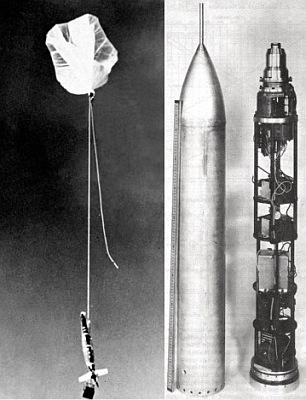Purpose of the flight and payload description
The so-called ROCKOON (Rocket-Balloon) technique enabled small rockets to reach higher altitudes by launching them from a stratospheric balloon. The balloon would ascend to approximately 70,000 feet, where the rocket was fired using an onboard timer, a pressure switch, or telecommand. This innovative method was first employed in 1952 by Dr. James Van Allen, who was working at the State University of Iowa at the time.
The primary advantage of the rockoon combination was that it allowed the rocket to bypass the denser, lower layers of the atmosphere without expending its own propulsion energy. This resulted in a higher achievable apogee. However, the technique had a limitation: once released, the balloons could not be steered, making it impossible to precisely predict the rocket's launch direction or impact area. To address this safety concern, all rockoon missions were conducted from small vessels operating in open waters. This approach offered an additional benefit, as the ships could adjust their position to create "zero wind conditions," ideal for balloon launches.
The initial rockoon launches utilized a high-performance, small rocket known as DEACON. Developed in 1947 by Allegany Ballistics Laboratory for the Navy Bureau of Ordnance, the Deacon was originally designed to carry a 50-pound instrument payload to an altitude of approximately 20 miles. The rocket had no internal controls or movable surfaces and relied on fin-based arrow stabilization at its rear. Propulsion was provided by a JATO X220 solid propellant rocket motor. The Deacon measured 12.3 feet in length, had a diameter of 6.5 inches, and featured a fin span of 38.9 inches. When launched from a balloon at an altitude of around 70,000 feet, it could achieve speeds of approximately 3,000 mph and altitudes exceeding 60 miles.
The goal of the flight was to collect data on the physical properties of the Arctic upper atmosphere. Measurements of stagnation and ambient pressure, combined with trajectory data, were sufficient to determine pressure density and temperature profiles. Stagnation pressures at the nose probe tip were recorded using a 0-250 mm Hg differential pressure bellows gauge. For ambient pressure measurements, holes located 7 calibers from the probe tip maintained an ambient pressure chamber in the rocket's nose, while pressures below 100 microns were measured with a Pirani gauge positioned 7 calibers back from the rocket nose. A thermometer measured the temperature of the Pirani gauge case, an accelerometer tracked the rocket propellant's burning time, and a 25-mm Hg pressure switch activated the ambient pressure compressor and a data commutator. The collected data were transmitted via a two-channel FM-FM 300-milliwatt transmitter.
Details of the balloon flight
Balloon launched on: 8/8/1953 at 15:09 utc
Launch site: USS Staten Island (AGB-5)
Balloon launched by: General Mills Inc.
Balloon manufacturer/size/composition: Zero Pressure Balloon General Mills -- 68 foot
Flight identification number: GMI-1021
End of flight (L for landing time, W for last contact, otherwise termination time): 8/8/1953
Landing site: Payload no recoverable
The balloon was launched on August 8th, 1953 at 15:07 utc, from the deck of the U.S Coast Guard vessel Staten Island sailing at coordinates 73º37'N - 61º37'W. After reaching float altitude of 81.300 feet, the rocket was fired by the activation of the onboard timer at 17:01 utc. The apogee of the rocket was uncertain.
External references
- Arctic Upper-Atmosphere Pressure and Density Measurements with Rockets Journal of Geophysical Research, vol. 61, issue 1, pp. 77
- Final report ANNEX IX (High Altitude Balloon Research) General Mills Inc. Mechanical division April 1954
- Rocket measurements of the Arctic Upper Atmosphere IGY rocket report series Nº 1, 1958
- Upper Atmosphere Research Report Number 21. Summary of Upper Atmosphere Rocket Research Firings Naval Research Lab., Feb. 1954
2615If you consider this website interesting or useful, you can help me to keep it up and running with a small donation to cover the operational costs. Just the equivalent of the price of a cup of coffee helps a lot.


